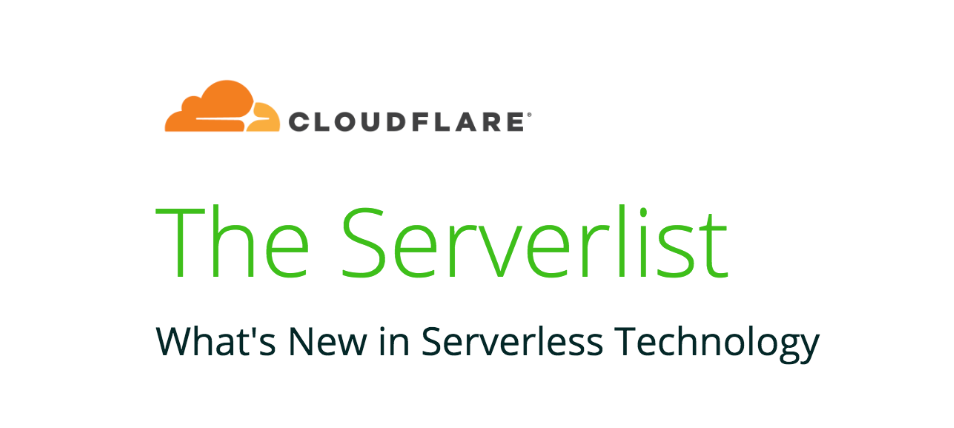Daily Roundup: Judge OKs T-Mobile, Sprint Merger
Judge gave T-Mobile a thumbs up on Sprint merger: IBM found billions of cloud misconfigs; and...
Fortinet, Amdocs Team Up to Woo SD-WAN Providers
The firewall and SD-WAN vendor claims by adding support for Amdoc's orchestration layer, it can...
The Serverlist: Globally Distributed Websites, $16M Series A, and more

Check out our twelfth edition of The Serverlist below. Get the latest scoop on the serverless space, get your hands dirty with new developer tutorials, engage in conversations with other serverless developers, and find upcoming meetups and conferences to attend.
Sign up below to have The Serverlist sent directly to your mailbox.
SD-WAN Explained: MPLS Alternative
The WAN is evolving and SD-WAN is all the rage. It promises to remove the constraints of legacy...
SDxCentral Will Not Attend MWC Barcelona
Ongoing coronavirus concerns are just too much to overlook at this point.
Equinix Taps Oracle Exadata for Interconnection Services
The colocation giant already partnered with Oracle and offered direct, private connections to...
T-Mobile Scores Court OK to Buy Sprint
The operators’ quest to merge, which began almost 22 months ago, has been held up by a group of...
Verizon Broadens 5G Lab Footprint to London
The move across the pond accentuates the stock that operators are putting in new use cases and...
Every Day Should Be Safer Internet Day

Safer Internet Day is an opportunity for people and organizations around the world to join forces in a series of activities and events dedicated to working towards a more secure Internet. I’m really excited to take part in the activities organized by the Brazilian hub of Safer Internet Day, where the topic of encryption in the Latin American and the Carribean region is going to be discussed in one of the panels.
It’s great to have a day dedicated to building a more secure Internet for everyone, however, the reality for most people championing digital security is that every day is safer Internet day. This is certainly the case at the Internet Society. Our global community of staff, Chapters, members, partners, and supporters are deeply committed to an open, globally-connected, secure, and trustworthy Internet for all. That’s why we aligned our 2020 Action Plan to focus on building a bigger and stronger Internet for everyone.
Digital security is the foundation of our connected economies and societies – and encryption is the bedrock of digital security. It protects the integrity, confidentiality, and authenticity of data and communications. And as a colleague of mine always says, “when we fail to protect data, Continue reading
Webinars in January 2020
January 2020 was one of the busiest months we ever had:
- Elisa Jasinska and Nick Buraglio started the year with the first part of Surviving in Internet Default-Free Zone webinar.
- Krzysztof Szarkowicz completed the EVPN-with-MPLS topic describing the intricacies of layer-2 and layer-3 integration, and extending the EVPN webinar to almost 11 hours (with three hours of it covering EVPN in SP/MPLS world).
- Matthias Luft continued the Cloud Security saga, covering logging, monitoring, testing and auditing.
- Preparing for our public cloud course, I described how you can automate AWS infrastructure deployments.
- Christopher Werny wrapped up the month with the second part of IPv6 Enterprise Security talk, this time focusing on layer-2 security.
You can get immediate access to all these webinars with Standard or Expert ipSpace.net subscription.
The Week in Internet News: Goodbye Yellow Brick Road

The FBI weighs in, again: The U.S. FBI, which has complained for years about the lack of access to encrypted communications, isn’t yet ready to call for legislation that would force tech companies to let police in, FCW.com reports. During a recent congressional hearing, Rep. Matt Gaetz (R-Fl.) asked if there was “meaningful legislation that Congress should consider so that technology partners have a yellow brick road to work with the government.” The decision “should be made by the American people through their elected representatives, not through one company making a business decision on behalf of all of us,” FBI Director Christopher Wray said.
Community networks rising: CircleID has a blog post featuring broadband predictions for 2020, including expectations that community broadband networks will see a “massive surge.” The prediction: “As the public becomes better acquainted with broadband policy issues thanks to the election cycle and the growing digital disparity, we are seeing that more and more communities are taking matters into their own hands.”
Super speedy: In related news, the UTOPIA Fiber network, boasting the fastest broadband speeds in the U.S., has expanded in Utah, KSL.com reports. The fiber network offers Continue reading
ONIE 2020 update
Even if it’s free, you still have to sell it. Yet a solution only works if people want to use it.
Last year I became the project lead for ONIE: the Open Network Install Environment. If you’re unfamiliar with this, ONIE is an open source project for installing operating systems on network switches. Manufacturers will start with the core ONIE code, add support for their new hardware (so that their new switch has an industry-standard way of installing an operating system) and then submit those changes back to the ONIE project.
As of 2020, this has happened over two hundred times, along with with well over a thousand contributions of bug fixes and improvements. As these changes are submitted, they need to be quality checked and tested to make sure they build cleanly. When I became the project lead, I had already been working on build tools at Cumulus Networks and decided my first contribution was going to be creating a standard build environment for ONIE that could be deployed anywhere.
This went great until my final test of the new build environment, which was to build every platform ONIE supported, and it didn’t go as well as I’d hoped. Continue reading
Daily Roundup: Coronavirus Hits MWC
MWC Barcelona hit by Coronavirus cancellations; Netskope scored $340M and got SASE; and Snowflake...